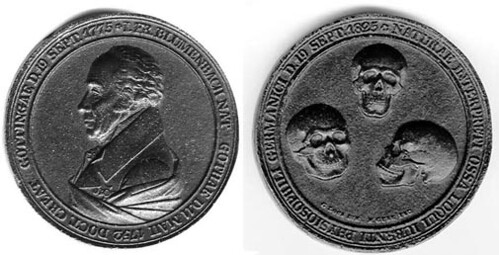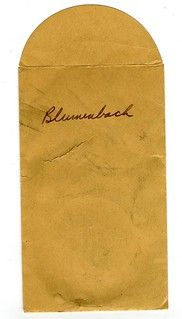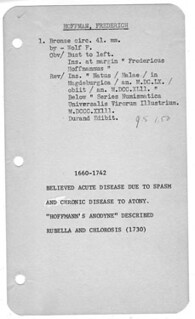
PREV ARTICLE
NEXT ARTICLE
FULL ISSUE
PREV FULL ISSUE
QUERY: MEDICAL MEDAL DONOR IDENTITY AND NEW DONORS SOUGHT
Gosia Fort has an interesting challenge for E-Sylum readers. Can anyone help her identify the donor of a nice collection of medical medals residing at the University of Pittsburgh?
-Editor
Who was this collector? Can we guess identity of a collector by looking at his collection? Maybe the collective knowledge of the readers can point me in the right direction.

As some of you know I am in charge of the Rare Book and Special Collections department of the Falk Library of the Health Sciences at the University of Pittsburgh (www.hsls.pitt.edu/about/libraries/falk/rarebook). I came across a nice collection of medals, which was buried and forgotten in the library’s offsite storage for who knows how many years. Above is an example of one of the medals.] There is no documentation accompanying this collection, no correspondence, no scrap of paper with a name or address which could help me to identify the previous owner. All I can infer comes from the artifacts themselves. There are 44 medals, some dating as far back as the late 15th century though the bulk of the collection dates from the 19th and early 20th centuries. Most of the medals in the collection are devoted to men famous in the field of medicine. A few do not match these criteria: there are four tokens and one coin among the medals, six medals are loosely or not connected to medicine at all (poet Schiller, Cardinal Mercier, French politicians and a First World War propaganda medal). However, the core of the collection has strict medical focus. I presented one medal from the collection in our newsletter. Each medal was stored in a yellow envelope with a handwritten subject (all in the same penmanship) and was accompanied by a typed note card with a medal description and a catalog card with the name of the subject and additional information on the importance or relevance of the person to the field. There are more cards and envelopes than medals so I assumed that not all the medals were donated to the library. Out of 30 missing medals many commemorated really big personalities in medicine like Boerhaave, Charcot, Koch, and Leeuwenhoek. Maybe they were sold as more valuable before the rest was given to the library?


There are no medals issued after 1936, so I assumed that nothing was added to the collection since then. There is no indication when the medals were donated to the library, by whom and for how long they were stored in a box waiting for me to find them. If my assumption is correct that the cards with descriptions were done by the owner, then I can also infer from the notes that he was a member of one of the local medical societies. Do any of you know of a doctor or medical researcher who was also a numismatist and active as a collector during the first half of the 20th century in Pittsburgh? Does anyone recognize the style of handwriting? If you do, please contact me at gosia@pitt.edu
Here's an addendum by Tom Fort (Gosia’s husband).
-Editor
My wife, being a typical Polish academic, is too humble to ask for help in maintain and/or possibly improving this collection of medals that was found in the offsite storage area. The Medical Library’s rare book acquisition and maintenance budget can simply be summed up in the word — zero. The university pays for the reading room and climate controls as well insuring the collection but beyond that it receives nothing. The Rare Book collection totally depends upon gifts made by parties who are interested in having their books or other medical items retained in an academic institution where they can be made available for further study. It is my wife’s plan to catalogue and post the entire collection of medals (including photos) on the web site. However, she needs people’s help. Here is how you can aid this project: 1. Numismatic Literature. Neither the Medical Library or the university’s main library have any monographs on the subject of medicine and numismatics. Copies of Storer’s Medicina in Nummis, Freeman’s Medals Relating to Medicine and Applied Sciences in the Numismatic Collection of Johns Hopkins University and Forrer’s Biographical Dictionary of Medalists would be very helpful to say the least. My wife has been able to access copies via interlibrary loan but it would be far more convenient if she, and other researchers, had copies at hand in the rare book room. Likewise, any auction catalogues that have large collections of medals relating to medicine in them would be of immense use. 2. Actual medals. Numerous medals relating to medical research have been issued since 1936, likewise there are many from before that year which are missing from the collection. It would be wonderful if interested parties could continue to add to this group for future researchers. 3. Money. The library does not even have funds to pay for proper storage trays. I donated a couple but the spaces are two by two and many of the medals will not fit. Likewise, any monetary donations can go towards the acquisition of books to support research (see number 1 above) and the purchasing of material that adds to the collection. Please remember that all donations are tax deductible! A final word. Please contact my wife (gosia@pitt.edu) before you send any money, books or medals to make sure the collection needs them.
This collection is a worthy cause deserving of the support of the hobby. Who can step up and contribute?
-Editor

Wayne Homren, Editor The Numismatic Bibliomania Society is a non-profit organization promoting numismatic literature. See our web site at coinbooks.org. To submit items for publication in The E-Sylum, write to the Editor at this address: whomren@gmail.com To subscribe go to: https://my.binhost.com/lists/listinfo/esylum All Rights Reserved. NBS Home Page Contact the NBS webmaster 
|